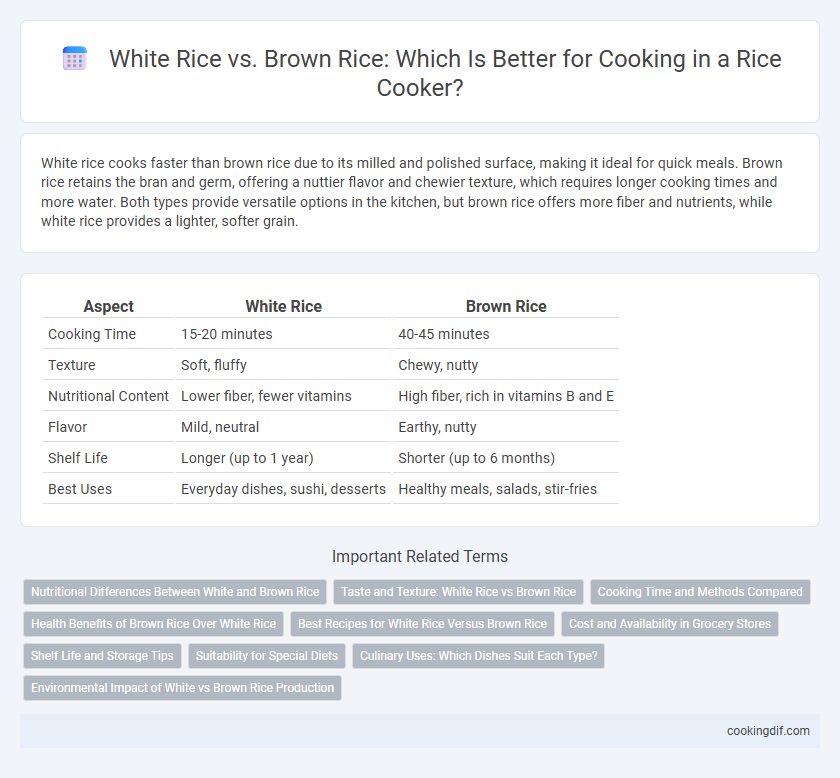White rice cooks faster than brown rice due to its milled and polished surface, making it ideal for quick meals. Brown rice retains the bran and germ, offering a nuttier flavor and chewier texture, which requires longer cooking times and more water. Both types provide versatile options in the kitchen, but brown rice offers more fiber and nutrients, while white rice provides a lighter, softer grain.
Table of Comparison
| Aspect | White Rice | Brown Rice |
|---|---|---|
| Cooking Time | 15-20 minutes | 40-45 minutes |
| Texture | Soft, fluffy | Chewy, nutty |
| Nutritional Content | Lower fiber, fewer vitamins | High fiber, rich in vitamins B and E |
| Flavor | Mild, neutral | Earthy, nutty |
| Shelf Life | Longer (up to 1 year) | Shorter (up to 6 months) |
| Best Uses | Everyday dishes, sushi, desserts | Healthy meals, salads, stir-fries |
Nutritional Differences Between White and Brown Rice
Brown rice retains the bran and germ layers, providing higher fiber content, essential minerals like magnesium, phosphorus, and antioxidants compared to white rice, which is milled and polished, removing these nutrient-rich layers. White rice offers longer shelf life and quicker cooking time but has a higher glycemic index, potentially impacting blood sugar regulation adversely. Choosing brown rice supports better digestion, sustained energy release, and enhanced nutrient intake essential for heart health and metabolic functions.
Taste and Texture: White Rice vs Brown Rice
White rice offers a soft, fluffy texture with a mild, slightly sweet flavor that complements a wide range of dishes, making it a versatile choice in cooking. Brown rice has a chewier, nuttier taste and firmer texture due to its intact bran and germ layers, providing a more substantial mouthfeel. The cooking time for brown rice is longer, and its distinct texture adds a hearty element to meals compared to the smoother, more delicate consistency of white rice.
Cooking Time and Methods Compared
White rice cooks faster than brown rice, typically requiring 15-20 minutes versus 40-45 minutes for brown rice due to its milled and polished outer layer. Cooking methods for white rice often involve boiling or steaming with a 1:2 rice-to-water ratio, while brown rice needs more water, around 1:2.5, and benefits from soaking to reduce cooking time and improve texture.
Health Benefits of Brown Rice Over White Rice
Brown rice retains its bran and germ layers, providing higher fiber, antioxidants, and essential nutrients like magnesium and B vitamins compared to white rice, which is stripped of these components during processing. The increased fiber in brown rice promotes better digestion and helps regulate blood sugar levels, reducing the risk of type 2 diabetes. Its richer nutrient profile supports heart health and may aid in weight management, making it a healthier choice over white rice for cooking.
Best Recipes for White Rice Versus Brown Rice
White rice cooks faster and has a softer, fluffier texture ideal for recipes like risotto, fried rice, and sushi where a delicate grain is preferred. Brown rice retains its bran layer, providing a chewier texture and nutty flavor that enhances dishes such as grain bowls, pilafs, and hearty soups. Selecting white or brown rice depends on cooking time, texture preference, and nutritional goals for each recipe.
Cost and Availability in Grocery Stores
White rice is generally more affordable and widely available in grocery stores compared to brown rice, making it a cost-effective choice for many households. Brown rice, while often pricier due to its higher nutrient content and less processing, may be found in specialty or health food sections rather than standard aisles. Both varieties are stocked year-round, but white rice dominates in terms of both shelf presence and lower price points.
Shelf Life and Storage Tips
White rice has a longer shelf life, typically lasting up to 4-5 years when stored in an airtight container in a cool, dry place, while brown rice retains its natural oils and usually lasts about 6 months before becoming rancid. To maximize freshness, store both types in airtight containers away from moisture and heat, and consider refrigeration or freezing brown rice to extend its shelf life. Proper storage minimizes spoilage and preserves flavor, texture, and nutritional quality during cooking.
Suitability for Special Diets
White rice is often preferred for gluten-free and low-fiber diets due to its easy digestibility and minimal fiber content. Brown rice contains more fiber, vitamins, and minerals, making it suitable for diabetic and heart-healthy diets focused on blood sugar regulation and cholesterol management. Individuals with digestive sensitivities may benefit from white rice, while those seeking nutrient-dense options for weight management often choose brown rice.
Culinary Uses: Which Dishes Suit Each Type?
White rice, with its soft texture and mild flavor, is ideal for dishes like sushi, risotto, and pilafs where a delicate grain is desired. Brown rice offers a nuttier taste and chewier texture, making it suitable for hearty salads, stir-fries, and grain bowls that benefit from a more robust bite. The choice between white and brown rice impacts cooking time and absorption, influencing the final dish's texture and flavor profile.
Environmental Impact of White vs Brown Rice Production
Brown rice production generally has a lower environmental impact than white rice due to reduced processing, which conserves energy and decreases waste. The milling process for white rice removes the bran and germ layers, increasing resource consumption and generating more byproducts. Additionally, brown rice cultivation often supports better soil health and biodiversity through less intensive farming practices.
White rice vs Brown rice for cooking Infographic

 cookingdif.com
cookingdif.com